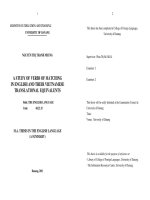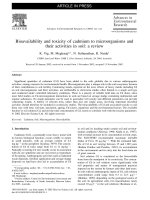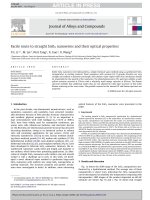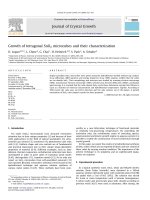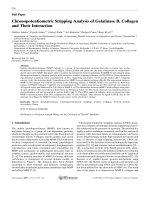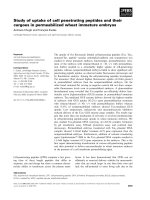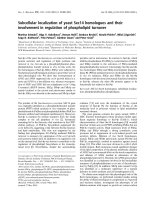- Trang chủ >>
- Khoa Học Tự Nhiên >>
- Vật lý
growth of tetragonal sno2 microcubes and their characterization
Bạn đang xem bản rút gọn của tài liệu. Xem và tải ngay bản đầy đủ của tài liệu tại đây (545.62 KB, 4 trang )
Growth of tetragonal SnO
2
microcubes and their characterization
O. Lupan
a,b,
Ã
, L. Chow
a
, G. Chai
c
, H. Heinrich
a,d
,S.Park
a
, A. Schulte
a
a
Department of Physics, University of Central Florida, P.O. Box 162385, Orlando, FL 32816-2385, USA
b
Department of Microelectronics and Semiconductor Devices, Technical University of Moldova, Stefan cel Mare Blvd. 168, Chisinau MD-2004, Republic of Moldova
c
Apollo Technologies, Inc. 205 Waymont Court, S111, Lake Mary, FL 32746, USA
d
Advanced Materials Processing and Analysis Center, Department of Mechanical, Materials, and Aerospace Engineering, University of Central Florida, Orlando, FL 32816, USA
article info
Article history:
Received 17 May 2008
Received in revised form
27 September 2008
Accepted 23 October 2008
Communicated by J.M. Redwing
Available online 5 November 2008
PACS:
81.10.
61.46.Àw
78.30.Fs
61.46.Hk
68.37.Hk
68.37.Lp
Keywords:
A1. Nanostructures
A2. Growth from solutions
B1. Oxides
B1. SnO
2
microcubes
abstract
Single-crystalline SnO
2
microcubes were grown using the hydrothermal method without any catalyst.
X-ray diffraction (XRD) patterns and energy dispersive X-ray (EDX) analysis verified that the cubes
are tin dioxide SnO
2
. Their morphology and structure was studied by scanning electron microscopy
(SEM), transmission electron microscopy (TEM), selected area electron diffraction (SAED), and Raman
spectroscopy. It is revealed that the cube-shaped SnO
2
crystal have dimension varying from 500 nm to
5
mm as a function of chemical concentration and hydrothermal temperatures regimes. According to
TEM results the cube axes are [0 0 1] direction and the side surfaces are {110} planes. A growth
mechanism of SnO
2
cube-shaped crystals has been proposed.
& 2008 Elsevie r B.V. All rights reserved.
1. Introduction
Tin oxide (SnO
2
) microcrystals have attracted researchers
attention due to their unique properties [1] and because of their
wide applications in the field of optical waveguides [2], ultra-
sensitive gas sensors [3], transistors [4], photosensors and solar
cells [3,5]. Uniform shape and size controls are of fundamental
and practical importance due to their unique shape-dependent
properties of material [6–8]. Different strategies, such as, laser
ablation, thermal evaporation, carbothermal reduction have been
investigated in order to grow cubes of transition metal oxides
[9,10], chalcogenides [11], transition metals [12]. So far only one
report on SnO
2
microcubes from self-assembled nanorods [13]
was reported. Recently, researchers’ attention were focused on the
hydrothermal technique and aqueous solution synthesis of
various metal oxides [14,15]. These methods have been note-
worthy as a new fabrication technique of functional materials
at relatively low-processing temperatures. By controlling the
nucleation sites, the coordination states of coexisting species,
supersaturated and kinetic growth regime in aqueous system it is
possible to enable the construction of novel architecture through
crystal growth.
In this paper, we report the results of a hydrothermal synthesis
of SnO
2
cubes (which are not reported till date) and size-control of
these cubes by varying reaction condition. The importance of the
present technique is its simplicity and no sophisticated equip-
ments are required.
2. Experimental procedure
In a typical synthesis route, SnCl
2
Á 2H
2
O and NH
4
OH (29.5%)
solution (from Fisher Scientific) were dissolved in a 100 ml
aqueous solution (deionized water with resistivity about 18.2 M
O
cm added with a 5ml of HCl (36%)). The solution was stirred
for 5 min at room temperature until it became homogeneous.
A silicon wafer and microscopic glass slide cleaned according to
previous work [16,17] were used as substrates. After mixing, the
ARTICLE IN PRESS
Contents lists available at ScienceDirect
journal homepage: www.elsevier.com/locate/jcrysgro
Journal of Crystal Growth
0022-0248/$ - see front matter & 2008 Elsevier B.V. All rights reserved.
doi:10.1016/j.jcrysgro.2008.10.072
Ã
Corresponding author at: Department of Physics, University of Central Florida,
P.O. Box 162385, Orlando, FL 32816-2385, USA. Tel.: +1407 8235217;
fax: +1407 8235112.
E-mail address: (O. Lupan).
Journal of Crystal Growth 311 (2008) 152–155
solution was transferred in a glass beaker with a sphericalconcave
cap with the radius of curvature of the surface of 10 cm and an
orifice (1 mm in radius) on the side [14]. The system was heated to
98 1C and kept for 15 min, then was allowed to cool to 40 1C
naturally. The products synthesized by described method were
then annealed at 370 1C for 10 min.
Synthesized material was analyzed and characterized by
scanning electron microscope (SEM), high-resolution transmis-
sion electron microscopy (HRTEM) (a FEI Tecnai F30 TEM), X-ray
diffraction (XRD), (Rigaku) and Raman spectroscopy. For the TEM
observation, the products were collected on a carbon holey grid.
The Raman spectra were obtained using a Horiba Jobin Yvon
LabRam IR system with a spatial resolution of 2
m
m. He–Ne laser
was used as an exciting source. This unit delivers o4 mW at the
sample at 633 nm and was used in this study with a spectral slit
width of approximately 2 cm
À1
.
3. Results and discussion
Fig. 1(a) displays SEM images of the cube-shaped SnO
2
crystals grown by a hydrothermal method on silicon (10 0)
substrates using 15–25 mM SnCl
2
Á 2H
2
O. Fig. 1(a) and (b) shows,
respectively, SEM of tin oxide microcubes with length of each
side about 5–8
m
m and smaller cubes with length of each side
about 500 nm. Different sizes were obtained by changing the
concentration using 30–40 mM SnCl
2
Á 2H
2
O and by varying the
kinetic growth regime, thus for sample shown in Fig. 1(b)
temperature gradient was lower by 0.5 1C/s, than for sample
shown in Fig. 1(a).
Each face of the SnO
2
microcubes is a square. Evidence
of the faultless shape is given by the SEM image (Fig. 1(a) and
(b)) where eight vertices and six faces can be observed. Every face
is not only flat and smooth, but also is perpendicular to its
adjacent faces.
The general morphology of the different sizes microcubes are
shown in Fig. 1(b), which shows that in addition to the larger
microcubes, there are also smaller cubes. Growth of two types
of cubes bigger (length of each side 5–8
m
m) and smaller (length
of each side 0.5
m
m) for the anisotropic crystal can be adjusted
by balance between the thermodynamic and the kinetic growth
regimes. Also, as the quantity of the nuclei depends on the
concentration of the precursor we observed that by increasing the
concentration of Sn(OH)
6
2À
generated more nuclei, which benefits
the formation of nanocrystals with smaller cubes as displayed in
Fig. 1(b). The hydrothermal route was performed at 80 and 98 1C.
The crystals grown at 80 1C have curved and imperfect faces,
irregular shape, corners and rough surface (Fig. 1(c)). Fig. 1(c)
shows the SEM image of a tin oxide pyramided architecture grown
at 801C for the same duration of heating. In Fig. 1(d) a lower
magnification image of SnO
2
cubes synthesized on silicon
substrate is presented.
The chemical composition of the microcubes was determined
by EDX to be pure tin oxide. The XRD pattern is shown in Fig. 2,
which reveals the crystal structure and phase purity of the as-
synthesized microcubes. All of the diffraction peaks can be
indexed to the tetragonal SnO
2
structure with lattice parameters
a ¼ b ¼ 4.738 A
˚
and c ¼ 3.188 A
˚
(JCPDS 0 41-1445). No character-
istics peaks of other forms of tin oxide were detected.
Fig. 3(a) shows a typical high-resolution (HRTEM) image of one
edge of the cube-shaped SnO
2
crystal. In the inset in Fig. 3 is the
selected area electron diffraction (SAED) pattern of SnO
2
micro-
cubes. The spacing between the lattice planes along the cube
height and the width are 0.32 and 0.33 nm, which are in
agreement with distance between (0 01) and (11 0) planes of
rutile SnO
2
, respectively. The growth direction for the cubes
can be determined from SAED patterns. This confirmed that it
grew along [110] direction in lateral sides (indicated with an
arrow, perpendicular to the axis of a microcube). The distance
separation between lattice layers are found to be 0.33 nm
corresponding to lattice parameters of the rutile structure of
SnO
2
[11 0] reflection. No dislocations or other planar defects
were detected in the examined area of SnO
2
cubes. The growing is
along [0 0 1] and [110] directions in vertical and horizontal
planes, respectively, which is in accordance with the ‘‘lowest
energy’’ argument.
ARTICLE IN PRESS
Fig. 1. SEM images of the (a) typical as-synthesized SnO
2
microcube grown by
using 15–25 mM SnCl
2
Á 2H
2
O in aqueous solution; (b) different sizes SnO
2
microcubes grown by using 30–40 mM SnCl
2
Á 2H
2
O in aqueous solution; (c)
SnO
2
-pyramided architecture obtained by second process at 80 1C and (d) lower
magnification view showing monodisperse SnO
2
cubes distributed on substrate
surface.
Fig. 2. A typical X-ray diffraction (XRD) pattern obtained by using CuK
a
radiation
1.5406A of SnO
2
microcubes obtained by the aqueous solution method.
O. Lupan et al. / Journal of Crystal Growth 311 (2008) 152–155 153
Fig. 4 shows micro-Raman spectra of the as-grown SnO
2
cube
at room temperature. The tetragonal structure of SnO
2
belongs to
the space group D
4h
14
(P4
2
/mnm) with square pyramid as its
thermodynamically stable crystallographic form and has two
SnO
2
molecules per unit cell. It has a ditetragonal bipyramid type
of symmetry and according to group theory [18] the normal lattice
vibration at the
G
point of the Brillouin zone is as follows [19]:
G
¼
G
þ
1
ð1A
1g
Þþ
G
þ
2
ð1A
2g
Þþ
G
þ
3
ð1B
1g
Þþ
G
þ
4
ð1B
2g
Þ
þ
G
À
5
ð1E
g
Þþ
G
À
1
ð1A
2u
Þþ2
G
À
4
ðB
1u
Þþ3
G
þ
5
ðE
u
Þ (1)
where the A
1g
,B
1g
,A
2g
and E
g
modes are Raman active and A
2g
and
B
1u
modes are inactive.
In Fig. 4, there are peaks at 476, 634, 659, 693, and 776 cm
À1
in
the Raman spectrum which are in agreement with those of a rutile
SnO
2
single crystal [20] and are in agreement with the data from
group-theory analysis also [21,22]. These peaks are attributed to
the E
g
,A
1g
,(A
u
)
n
3(TO)
,A
2u
, and B
2g
vibrational modes of SnO
2
[23].
These modes confirm the rutile structure of SnO
2
cubes. In
comparison with the SnO
2
powder, additional Raman bands at
659 and 693cm
À1
can be observed in the SnO
2
micron cube-
shaped crystals, which can be attributed to the (E
u
)
n
3(TO)
,
IR-activated (A
2u
)
n
(LO)
for LO, calculated theoretically [24] and
also observed experimentally [25].
4. A proposed growth mechanism
A proposed growth mechanism for SnO
2
micron cube-shaped
crystals, in terms of chemical reactions and crystal growth is
described here. From the crystallization point of view, the
formation of an oxide during of an aqueous solution reaction is
expected to experience a hydrolysis–condensation (nucleation-
growth) process. The growth process of SnO
2
microcubes can be
simplified as the following reactions [26,27]:
NH
4
OH2NH
3
þ H
2
O (1)
2H
2
O3H
3
O
þ
þ OH
À
; K
w
¼ 10
À14
ion-product constant (2)
At the beginning in aqueous solution with an OH
À
excess, a
higher Sn
2+
ion concentration accelerates the nucleation process
[27] and nuclei are formed
Sn
2þ
þ 2OH
À
! SnðOHÞ
2
(3)
SnðOHÞ
2
þ 2OH
À
!½SnO
2
2À
þ 2H
2
O (4)
The amphoteric hydroxide dissolves in excess of ammonia
solution and forms [Sn(OH)
4
]
2À
anions
SnðOHÞ
2
þ 2OH
À
!½SnðOHÞ
4
2À
(5)
The amphoteric hydroxide [Sn(OH)
4
]
2À
dissolves in ammonia
solution and forms [Sn(OH)
6
]
2À
anions.
During the hydrothermal reaction, the [Sn(OH)
6
]
2À
ions
decomposed into SnO
2
½SnðOHÞ
6
2À
À!
kinetic growth regime
SnO
2
þ 2H
2
O þ 2OH
À
(6)
The formation of cube-shape SnO
2
structures was fundamen-
tally achieved with the progress of the crystal growth. The
concentration of tin ions in solution is of influencing to the size
of cubes. The kinetic growth regime during the hydrothermal
reaction is a decisive factor in formation of cube-shaped crystals.
Also, the hydrothermal temperature is an important factor
affecting tin oxide growth. In Fig. 1 images of different SnO
2
cubes and architectures synthesized on substrate are presented.
We also observed that increasing the temperature and extending
the heating duration will lead to an increase of the volume sizes of
cubes. Different shapes cubes were obtained at 80 1C (pyramided
architecture shown in Fig. 1(c)), but no crystals deposition
occurred at temperatures lower than 80 1C.
In our experiments, the hydrothermal process using described
reaction media allows a slow nucleation and growth at low-
interfacial tension conditions, which favors the generation of
cube-shaped SnO
2
crystals. The growth mechanism of perfect
shaped SnO
2
microcubes can be explained on base of its rutile
structure, which is 6:3 coordinated and the bonding between
atoms has a strong ionic character. The synthesized material is a
cube-shaped crystal because of the tetragonal unit cell containing
two tin atoms and four oxygen atoms. As was determined
experimentally, the crystal growth is enclosed by the stable
(11 0) facets, thus the rutile structure is built up from neutral
stacked layers of the following planes (O), (2Sn+O), and (O) with
ARTICLE IN PRESS
Fig. 3. (a) HRTEM micrograph of SnO
2
microcubes grown at 951C and (b) SAED
image of SnO
2
microcubes.
Fig. 4. Micro-Raman scattering spectra of the cube-shaped tin oxide crystal.
O. Lupan et al. / Journal of Crystal Growth 311 (2008) 152–155154
ionic charges 2À, 4+, and 2À, respectively, in the surface unit cell.
In this way, a termination is possible with these planes of the
tin oxide (110) called a stoichiometric surface. According to our
results tin oxide can grow from solutions in well-defined cubic
edges and giving a proper morphology. Understanding of the
growth mechanism of cubic structure is very important for the
synthesis of new materials as well as for device applications.
Thus, by carefully adjusting the balance between the thermo-
dynamic and kinetic growth regimes, crystals with geometrical
morphology consistent with their crystallographic structure can
be formed. Also by controlling the kinetic growth regime the
anisotropic growth along the high-energy crystallographic face
can be promoted [28]. It is known that tin oxide with rutile
structure belongs to the (P4
2
/mnm) space group with square
pyramid as its thermodynamically stable crystallographic form
[18,29]. According to theoretical studies [30,31] it is suggested
that the surface energy sequence of SnO
2
is E(110)oE(1 0 0)
oE(10 1)oE(0 0 1). Thus, the (110) surface which is the most
thermodynamically stable [30] and the plane (11 0) with the
lowest surface energy for SnO
2
has preferential growth and would
be expected to feature predominantly in the cube morphology.
In this way the (11 0) lateral growth can be explained and
cube-shaped tin oxide crystals can be realized through the
chemical reaction in a non-equilibrium kinetic regime using a
hydrothermal process.
5. Conclusion
In summary, SnO
2
microcubes were successfully synthesized
by a simple hydrothermal method. XRD, TEM, SEM, EDX and
Raman spectroscopy reveal that the SnO
2
cubes surfaces are very
smooth, and are of a crystalline rutile structure. The vertical
growth direction is [0 0 1] and the side-faces of SnO
2
are {11 0}
planes. The obtained structures can be used for further studies of
lattice dynamics of rutile. Peaks at 476, 634, 659, 693, and
776 cm
À1
in the Raman spectrum which are in agreement with
those of a rutile SnO
2
single crystal [20] and they are attributed to
the E
g
,A
1g
,(E
u
)
n
3(TO)
,A
2u
, and B
2g
vibrational modes of SnO
2
[23].
These modes confirm the rutile structure of SnO
2
cubes. Proposed
synthesis process is easy and cost-effective, as the microcubes
growth was carried out in an aqueous solution, which does not
require any sophisticated equipment. Also, a crystal growth
mechanism for cube-shaped SnO
2
crystals has been proposed.
These findings have significant scientific and technological
implications in crystal growth topic may gain greater importance
due to the necessity in controlling shape and size of the
synthesized materials.
Acknowledgements
Dr. L. Chow acknowledges financial support from the Apollo
Technologies, Inc. and the Florida High Tech Corridor Research
Program. The research described here was made possible in part
by an award for young researchers (MTFP-1014B Follow-on) from
the Moldovan Research and Development Association (MRDA)
under funding from the US Civilian Research & Development
Foundation (CRDF). Financial support by the RFFI Project 036/R
are gratefully acknowledged. Raman measurements were sup-
ported in part by NSF MRI grant DMR-0421253.
References
[1] C. Kilic, A. Zunger, Phys. Rev. Lett. 88 (2002) 095501.
[2] M. Law, D.J. Sirbuly, J.C. Johnson, J. Goldberger, R.J. Saykally, P. Yang, Science
305 (2004) 1269.
[3] P.G. Harrison, W.J. Willet, Nature 332 (1988) 337.
[4] M.S. Arnold, P. Avouris, Z.W. Pan, Z.L. Wang, J. Phys. Chem. B 107 (2002) 659.
[5] M. Law, H. Kind, B. Messer, F. Kim, P.D. Yang, Angew. Chem. Int. Ed. 41 (2002)
2405.
[6] Z. Lu, J. Liu, Y. Tang, Y. Li, Inorg. Chem. Commun. 7 (2004) 731.
[7] A.P. Alivisatos, Science 271 (1996) 933.
[8] X.G. Peng, L. Manna, W.D. Yang, J. Wickham, E. Scher, A. Kadavanich,
A.P. Alivisatos, Nature 404 (2000) 59.
[9] J. Feng, C. Zeng, Chem. Mater. 15 (2003) 2829.
[10] Y.B. Zhao, Z.J. Zhang, H.X. Dang, J. Phys. Chem. B 107 (2003) 7574.
[11] E. Lifshitz, M. Bashouti, V. Kloper, A. Kigel, M.S. Eisen, S. Berger, Nano Lett. 3
(2003) 857.
[12] Y.G. Sun, Y.N. Xia, Science 298 (2002) 2176.
[13] D. Qin, P. Yan, G. Li, J. Xing, Y. An, Mater. Lett. 62 (16) (2008) 2411.
[14] O. Lupan, L. Chow, G. Chai, B. Roldan, A. Naitabdi, A. Schulte, Mater. Sci. Eng. B:
Solid-State Mater. Adv. Technol. 145 (2007) 57.
[15] C.Y. Wang, G.M. Zhu, S.L. Zhao, Z.Y. Chen, Z.G. Lin, Mater. Res. Bull. 36 (2001)
2333.
[16] O.I. Lupan, S.T. Shishiyanu, L. Chow, T.S. Shishiyanu, Thin Solid Films 516
(2008) 3338.
[17] O. Lupan, L. Chow, S. Shishiyanu, E. Monaico, T. Shishiyanu, V. S
-
ontea, B.
Roldan, A. Naitabdi, S. Park, A. Schulte, Mater. Res. Bull. 44 (2009) 63.
[18] J.G. Traylor, H.G. Smith, R.M. Nicklow, M.K. Wilkinson, Phys. Rev. B 3 (1971)
3457.
[19] Z.W. Chen, J.K.L. Lai, C.H. Shek, Phys. Rev. B 70 (2004) 165314.
[20] J.F. Scott, J. Chem. Phys. 53 (1970) 852.
[21] H. Kohno, T. Iwasaki, Y. Mita, S. Takeda, J. Appl. Phys. 91 (2002) 3232.
[22] V.G. Kravets, Opt. Spectrosc. 103 (2007) 766.
[23] P.S. Peercy, B. Morosin, Phys. Rev. B 7 (1973) 2779.
[24] R.S. Katiyars, P. Dawsons, M.M. Hargreaves, G.R. Wilkinson, J. Phys. C: Solid
State Phys. 4 (1971) 2421.
[25] J.X. Zhou, M.S. Zhang, J.M. Hong, Z. Yin, Solid State Commun. 138 (2006) 242.
[26] J. Zhang, L.D. Sun, J.L. Yin, H.L. Su, C.S. Liao, C.H. Yan, Chem. Mater. 14 (2002)
41 72.
[27] D.F. Zhang, L.D. Sun, J.L. Yin, C.H. Yan, Adv. Mater. 15 (2003) 1022.
[28] S.M. Lee, S.N. Cho, J. Cheon, Adv. Mater. 15 (2003) 441.
[29] L. Vayssieres, M. Graetzel, Angew. Chem. Int. Ed. 43 (2004) 3666.
[30] B. Slater, C. Richard, A. Catlow, D.H. Gay, D.E. Williams, V. Dusastre, J. Phys.
Chem. B 103 (1999) 10644.
[31] E.R. Leite, T.R. Giraldi, F.M. Pontes, E. Longo, Appl. Phys. Lett. 85 (2003) 1566.
ARTICLE IN PRESS
O. Lupan et al. / Journal of Crystal Growth 311 (2008) 152–155 155
